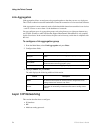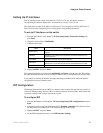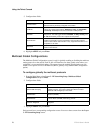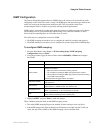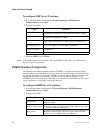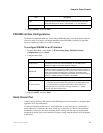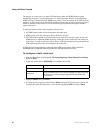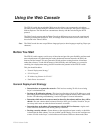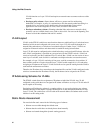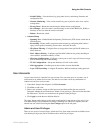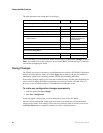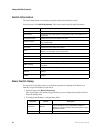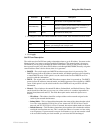82 ZT8101 Users Guide
Using the Web Console
VLANs function as a Layer 2 VLAN and require an external router to connect to the rest of the
network.
• Develop a policy scheme—Some subnets will have a greater need for multicasting
bandwidth, for example. A policy is a mechanism to alter the normal packet forwarding in a
network device, and can be used to intelligently allocate bandwidth to time-critical
applications such as the integration of voice, video, and data on the network.
• Develop a redundancy scheme—Planning redundant links and routes to network-critical
resources can save valuable time in case a link or device fails. You can use the Spanning Tree
Protocol to block the redundant link until it is needed.
VLAN Layout
VLANs on the ZT8101 switch have more functions than on a traditional Layer 2 switch and must
therefore be laid-out and configured with a more care. Layer 3 VLANs could be thought of as
network links rather than as a collection of associated end users. Further, Layer 3 VLANs are
assigned an IP network address and subnet mask to enable IP routing between them.
Layer 3 VLANs must be configured on the switch before they can be assigned IP subnets. Also, the
static VLAN configuration is specified on a per port basis. On the ZT8101 switch, a VLAN can
consist of end-nodes, just like a traditional Layer 2 switch. But a VLAN can also consist of one or
more Layer 2 switches, each of which is connected to multiple end nodes or network resources.
For example, a Layer 3 VLAN, consisting of four ports, could be connected to four switches. If
these switches each have 24 ports, then the Layer 3 VLAN would contain 96 (4 x 24) end nodes.
Assigning an IP subnet to the Layer 3 VLAN would allow wire-speed IP routing from the WAN to
each end node and between end nodes.
Therefore, the IP subnets for a network must be determined first, and the VLANs configured on the
switch to accommodate the IP subnets. Finally, the IP subnets can be assigned to the VLANs.
IP Addressing Scheme for VLANs
The ZT8101 switch allows the assignment of IP subnets to individual VLANs. Any VLAN
configured on the switch that is not assigned an IP subnet will behave as a Layer 2 VLAN and will
not be capable of IP routing.
Developing an IP addressing scheme is a complex subject. As you are developing your scheme,
remember that the switch requires a unique IP addreess for all the anticipated end nodes on each
Layer 3 VLAN. The switch treats a VLAN with an IP network address and subnet mask as an IP
interface in an IP routing mode.
Static Route Assessment
You need to define static routes for the following types of subnets:
• Subnets not accessible through the default route
• Subnets that the switch does not already know about internally
• Subnets not learned through the dynamic routing protocols



